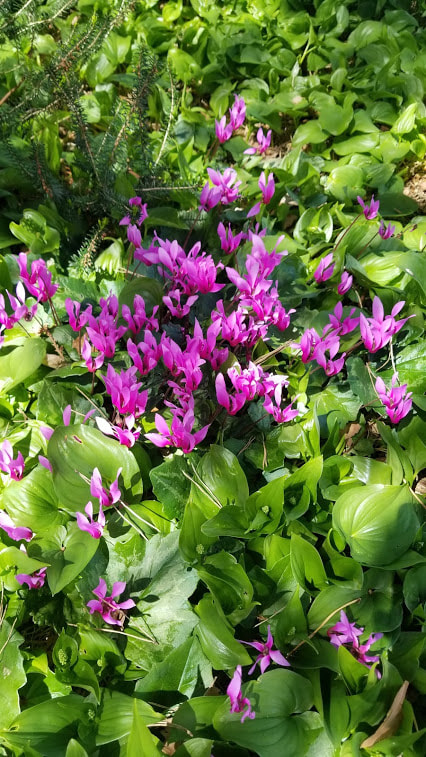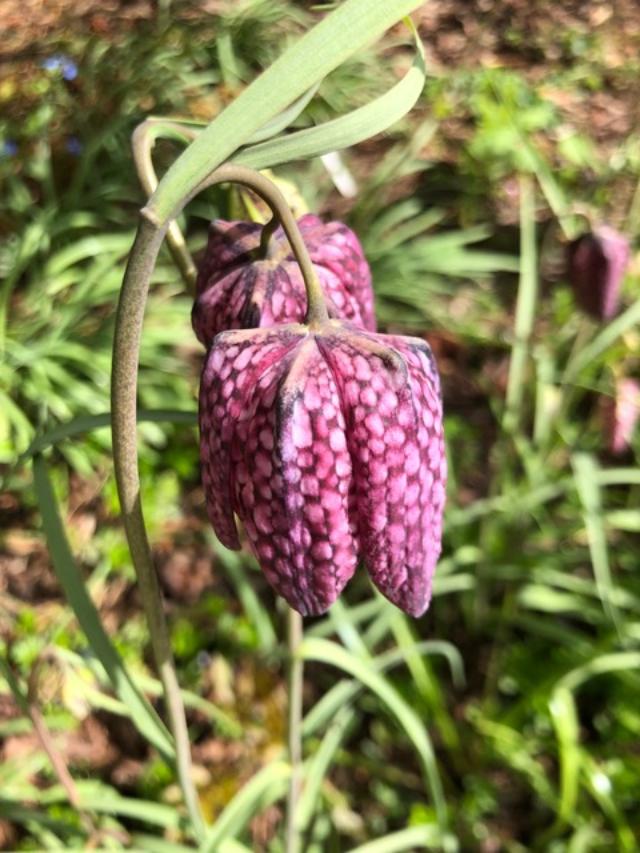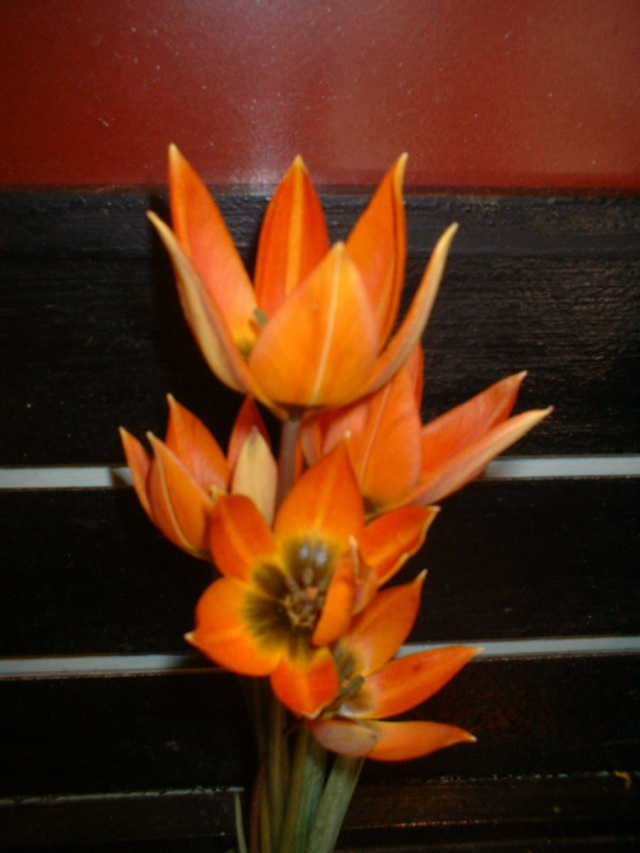- Plant IDs
- >
- ID By Type
- >
- Bulbs, Corms, Rhizomes, and Tubers
- >
- Bulbs
Scroll to the bottom of the page for a few musings on bulbs to provoke interest in this group of plants for yourselves and visitors:
Erica's Original Notes
Allium: While not part of Erica's original notes, these stalwarts of our Garden bloom from spring to early summer. Perhaps the most impressive is Allium hollandicum 'Purple Sensation' which is planted under the magnificent yellow-flowering Laburnum x wateri 'Vossii' in the Laburnum Walk. [2015]
Anenome: Anemone coronaria. At the time of the Crusades, Bishop Umberto of Pisa, after blessing the soldiers before they embarked for the Holy Land, asked them to bring back soil from the Crusades as ballast instead of the usual seashore sand. This soil was spread in Pisa's Campo Sancta to honour the dead. The following spring, everyone was amazed to find a carpet of scarlet anemones; thus it was that they were called 'Blood Drops of Christ'. In the seventeenth century Maître Bachelieu, a Parisian florist, produced some extra large and colourful varieties which he refused to sell. However, a crafty Burgomaster from Antwerp was able to collect seeds by dropping his cloak at the appropriate moment while visiting the florist. He wasn't the first person to 'lift' something in a garden, nor, I'm sure the last!
Chionodoxa: 'Chion' is Greek for snow; the blue flowers open wide with a white centre on a swollen base. These are commonly called 'Glory of the Snow'.
Colchicum autumnale: The autumn crocus is a member of the Lily family and should not be confused with the true crocus which is in the Iris family. It is also known as 'naked lady' or, more poetically in French, 'Les Belles Dames sans Chemises' [beautiful women without blouses]. All parts of it are poisonous, it is used in genetic research, and it is useful in the treatment of gout!
Crocus: in the Iris family. Crocus sativus is from Greece but thought to have originated in Mongolia. It is a source of the valuable spice saffron ('zafaran' is Arabic for 'yellow' and 'krokos is Greek for saffron). It takes 250,000 stamens to make one pound of saffron, and, being handpicked, this makes it the most expensive of spices, the best coming from Spain. When it was weighed, the windows were closed as a precaution against it blowing away. The saffron industry in England was formed 500 years ago in Saffron Walden near Cambridge. Saffron used to be adulterated with calendula. Henry VIII outlawed the dyeing of sheets with saffron as it masked the dirt! Sometimes called autumn crocus, it is not to be confused with Colchicum autumnale.
Cyclamen: mostly from around the Mediterranean; their greatest concentration is in Greece, Italy and the former Yugoslavia. They may bloom in the spring, e.g. Cyclamen coum and C repandum, or in the fall after the first rains, such as C. hederifolium. The tubers may live to a ripe old age, 100 years or more! Cyclamen are in the Primulaceae family, and ants are largely responsible for dispersal of their seeds [myrmecochory].
Fritillaria: Fritillaria meleagris, known as 'dice box' because, when you peer inside the bell-like chequered flowers, you see the six white nectaries looking like dice. F. Imperialis, the Crown Imperial, one of the oldest known cultivated plants from Persia and India, is often seen in old Dutch paintings with its tufted crown of leaves. Legend has it that it once had upward facing white flowers, but in the Garden of Gethsemane, when other plants hung their heads in humility as Christ passed by, this plant was too proud to do so. God rebuked it, whereupon it blushed red, hung its head and tears came, which can be seen today as nectaries.
Iris reticulata: late February bloomer in the Alpine Garden. 'Katharine Hodgkin' (photo above) has tiger-striped, nearly translucent petals, quite different from some of her dark blue/purple cousins. [2013]
Leucojum: in the Amaryllidaceae family and closely related to Galanthus, 'snowdrop'. Leucojum grows taller than the snowdrop; its petals and sepals are of the same length, whereas in the snowdrop, the inner petals are shorter.
Lilium: The Madonna Lily, Lilium candidum, was cultivated by the Cretans and Egyptians, as seen on their vases. Later, in Renaissance paintings, this flower was a symbol of purity, associated since mediaeval times with the Virgin Mary. Hidden at the western edge of the Great Lawn is the spectacular Cardiocrinum giganteum, the giant Himalayan Lily.
Narcissus: The word 'daffodil' comes from the word 'asphodel', the flower of the Elysian Fields. The genus was named after Narcissus, a vain Greek youth doomed to look at his own reflection, until Nemesis took pity on him and turned him into a flower. [More stories about Narcissus] [Weekly Update notes]
Puschkinia: pretty powder-blue flower with a deep blue stripe on each petal; the corolla tube is united. Every spring these bulbs, Puschkinia and Chionadoxa, make us puzzle anew as to which is which!
Scilla: sepals separated to the base, and there is no white centre to the flower.
Tulipa: cultivated in Turkey where it grows wild. It was brought to the attention of the Western world in 1554 by the Austrian Ambassador to Turkey, and, by 1634 in Holland, one bulb sold for $1,200. The excitement about tulips got so out of hand that before the bulb boom burst, one bulb was sold for $5,000 PLUS a carriage and horses! 'Tulbend' is Turkish for tulip; 'tulipans' is the Dutch name meaning turban - inverted, one might add! It may have been the Rose of Sharon in the Bible.
Erica's Original Notes
Allium: While not part of Erica's original notes, these stalwarts of our Garden bloom from spring to early summer. Perhaps the most impressive is Allium hollandicum 'Purple Sensation' which is planted under the magnificent yellow-flowering Laburnum x wateri 'Vossii' in the Laburnum Walk. [2015]
Anenome: Anemone coronaria. At the time of the Crusades, Bishop Umberto of Pisa, after blessing the soldiers before they embarked for the Holy Land, asked them to bring back soil from the Crusades as ballast instead of the usual seashore sand. This soil was spread in Pisa's Campo Sancta to honour the dead. The following spring, everyone was amazed to find a carpet of scarlet anemones; thus it was that they were called 'Blood Drops of Christ'. In the seventeenth century Maître Bachelieu, a Parisian florist, produced some extra large and colourful varieties which he refused to sell. However, a crafty Burgomaster from Antwerp was able to collect seeds by dropping his cloak at the appropriate moment while visiting the florist. He wasn't the first person to 'lift' something in a garden, nor, I'm sure the last!
Chionodoxa: 'Chion' is Greek for snow; the blue flowers open wide with a white centre on a swollen base. These are commonly called 'Glory of the Snow'.
Colchicum autumnale: The autumn crocus is a member of the Lily family and should not be confused with the true crocus which is in the Iris family. It is also known as 'naked lady' or, more poetically in French, 'Les Belles Dames sans Chemises' [beautiful women without blouses]. All parts of it are poisonous, it is used in genetic research, and it is useful in the treatment of gout!
Crocus: in the Iris family. Crocus sativus is from Greece but thought to have originated in Mongolia. It is a source of the valuable spice saffron ('zafaran' is Arabic for 'yellow' and 'krokos is Greek for saffron). It takes 250,000 stamens to make one pound of saffron, and, being handpicked, this makes it the most expensive of spices, the best coming from Spain. When it was weighed, the windows were closed as a precaution against it blowing away. The saffron industry in England was formed 500 years ago in Saffron Walden near Cambridge. Saffron used to be adulterated with calendula. Henry VIII outlawed the dyeing of sheets with saffron as it masked the dirt! Sometimes called autumn crocus, it is not to be confused with Colchicum autumnale.
Cyclamen: mostly from around the Mediterranean; their greatest concentration is in Greece, Italy and the former Yugoslavia. They may bloom in the spring, e.g. Cyclamen coum and C repandum, or in the fall after the first rains, such as C. hederifolium. The tubers may live to a ripe old age, 100 years or more! Cyclamen are in the Primulaceae family, and ants are largely responsible for dispersal of their seeds [myrmecochory].
Fritillaria: Fritillaria meleagris, known as 'dice box' because, when you peer inside the bell-like chequered flowers, you see the six white nectaries looking like dice. F. Imperialis, the Crown Imperial, one of the oldest known cultivated plants from Persia and India, is often seen in old Dutch paintings with its tufted crown of leaves. Legend has it that it once had upward facing white flowers, but in the Garden of Gethsemane, when other plants hung their heads in humility as Christ passed by, this plant was too proud to do so. God rebuked it, whereupon it blushed red, hung its head and tears came, which can be seen today as nectaries.
Iris reticulata: late February bloomer in the Alpine Garden. 'Katharine Hodgkin' (photo above) has tiger-striped, nearly translucent petals, quite different from some of her dark blue/purple cousins. [2013]
Leucojum: in the Amaryllidaceae family and closely related to Galanthus, 'snowdrop'. Leucojum grows taller than the snowdrop; its petals and sepals are of the same length, whereas in the snowdrop, the inner petals are shorter.
Lilium: The Madonna Lily, Lilium candidum, was cultivated by the Cretans and Egyptians, as seen on their vases. Later, in Renaissance paintings, this flower was a symbol of purity, associated since mediaeval times with the Virgin Mary. Hidden at the western edge of the Great Lawn is the spectacular Cardiocrinum giganteum, the giant Himalayan Lily.
Narcissus: The word 'daffodil' comes from the word 'asphodel', the flower of the Elysian Fields. The genus was named after Narcissus, a vain Greek youth doomed to look at his own reflection, until Nemesis took pity on him and turned him into a flower. [More stories about Narcissus] [Weekly Update notes]
Puschkinia: pretty powder-blue flower with a deep blue stripe on each petal; the corolla tube is united. Every spring these bulbs, Puschkinia and Chionadoxa, make us puzzle anew as to which is which!
Scilla: sepals separated to the base, and there is no white centre to the flower.
Tulipa: cultivated in Turkey where it grows wild. It was brought to the attention of the Western world in 1554 by the Austrian Ambassador to Turkey, and, by 1634 in Holland, one bulb sold for $1,200. The excitement about tulips got so out of hand that before the bulb boom burst, one bulb was sold for $5,000 PLUS a carriage and horses! 'Tulbend' is Turkish for tulip; 'tulipans' is the Dutch name meaning turban - inverted, one might add! It may have been the Rose of Sharon in the Bible.
Bulbs

Allium atropurpureum
CA$0.00
CA$0.00

Allium cernuum
CA$0.00
CA$0.00

Allium cristophii
CA$0.00
CA$0.00

Allium 'Forelock'
CA$0.00
CA$0.00

Allium giganteum
CA$0.00
CA$0.00

Allium hollandicum 'Purple Sensation'
CA$0.00
CA$0.00

Allium 'Millenium'
CA$0.00
CA$0.00

Allium moly
CA$0.00
CA$0.00

Allium 'Mount Everest'
CA$0.00
CA$0.00

Allium schoenoprasum 'Forescate'
CA$0.00
CA$0.00

Allium schubertii
CA$0.00
CA$0.00

Allium siculum
CA$0.00
CA$0.00

Allium sphaerocephalon
CA$0.00
CA$0.00

Alstroemeria aurea
CA$0.00
CA$0.00

Anemone coronaria 'Sylphide'
CA$0.00
CA$0.00

Camassia leichtlinii
CA$0.00
CA$0.00

Camassia quamash
CA$0.00
CA$0.00

Cardiocrinum giganteum
CA$0.00
CA$0.00

Cyclamen repandum
CA$0.00
CA$0.00

Eranthis hyemalis
CA$0.00
CA$0.00

Erythronium americanum
CA$0.00
CA$0.00

Erythronium 'Kondo'
CA$0.00
CA$0.00

Erythronium revolutum
CA$0.00
CA$0.00

Fritillaria imperialis
CA$0.00
CA$0.00

Fritillaria meleagris
CA$0.00
CA$0.00

Fritillaria persica
CA$0.00
CA$0.00

Galanthus elwesii
CA$0.00
CA$0.00

Galanthus ikariae
CA$0.00
CA$0.00

Galanthus nivalis
CA$0.00
CA$0.00

Galanthus nivalis 'Flore Pleno'
CA$0.00
CA$0.00

Hyacinthoides hispanica
CA$0.00
CA$0.00

Iris 'Katharine Hodgkin'
CA$0.00
CA$0.00

Lilium formosanum var. pricei
CA$0.00
CA$0.00

Lilium ‘Tabledance’
CA$0.00
CA$0.00

Merwilla plumbea
CA$0.00
CA$0.00

Muscari armeniacum 'blue spike'
CA$0.00
CA$0.00
Proudly powered by Weebly


